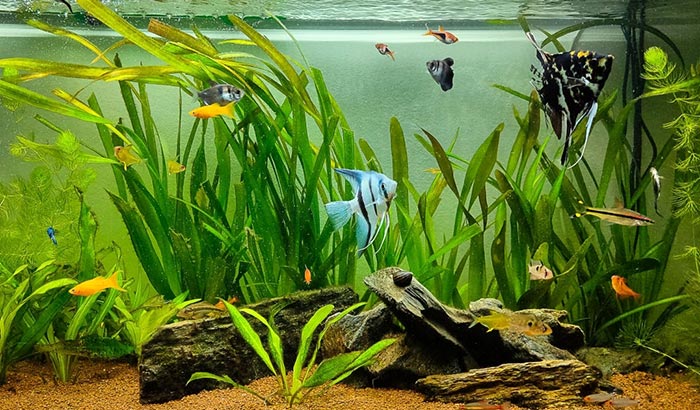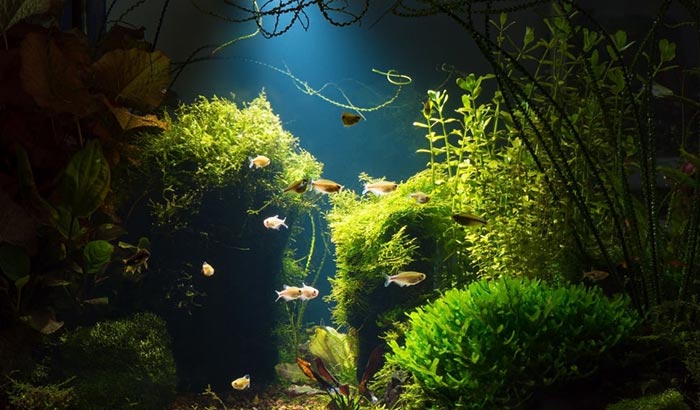Bringing in any new specimens to an aquarium will need careful consideration on your part. You have to be sure that the new organism does not carry any disease that will disrupt the delicate balance of the aquarium’s ecosystem. You need to know how to disinfect aquarium plants to keep the fish safe and happy with new plant additions.
This post will teach you how to quarantine and disinfect new aquarium plants. Let’s begin!
Contents
Why Disinfect Aquarium Plants?
The several reasons why you should learn to disinfect aquarium plants before introducing them to the tank are:
Snail Infestations
Snail infestation is the most common problem with introducing new plants to an aquarium. Unwanted snails often hitchhike on aquarium plants and make a home of your tank. While having snails in a fish tank is not terrible, having too much of them can feel like an invasion of the tank for the fish.
Parasites and Predators
While not as common as snail invasions, parasites and predators are more dangerous to your fish than snails. Parasites and predators can kill your fish within a few days of getting into the tank.
For example, dragonflies and damselflies can catch and eat fish and shrimps of their size! And once their nymphs get into the tank, it is near impossible to get rid of them utterly. The best way to save your tank from these pests is prevention.
Algae, Fungus, and Other Diseases
Some plants may carry algae, fungus, and other substances that mean bad news to your aquarium tenants. These substances can lower the quality of the life of your fish. They will get sick faster and lose their vibrant colors. Death is not a farfetched possibility.
Pesticides and Other Toxic Contaminants
The aquarium plants may not have strange organisms living in them because they were treated with pesticides. But without quarantine and disinfection, you are risking the toxic chemicals spreading all over the tank. Such an occurrence can result in a rapid decimation of your fish.
How to Disinfect Aquarium Plants
Now let’s get into the meat of this post. Here are the steps to disinfect aquarium plants.
Preparation for Disinfection
Before the actual disinfection process, you have to prep your plants. For the preparation method, you need first to clean your plant.
By cleaning the plant, I mean to remove dead leaves. Get rid of stones and soil in the roots. If it was shipped, make sure to remove all sponge-like materials that may have stuck to the plant. Such materials can absorb the chemicals you will use for disinfection. These are unnecessary additions you don’t want to be included in the tank.
If there are overgrown roots, you would want to cut them. Just trim 1–2 cm of the roots using a pair of scissors. Do not be afraid, as the roots will grow back.
Now, using clean tap water, gently rinse your plant. After thorough rinsing, set the plant aside because it is time for disinfection.
4 Disinfection Dips
There are four disinfection dips you can use to disinfect your plant, and you will need a separate tank for the process.
Just a reminder, while working on the sterilization or disinfectant, put on safety gloves and goggles. Work in a calm environment – an area less prone to accidents.
First Dip: Bleach (Chlorine)
Bleach, also known as sodium hypochlorite, is a familiar household cleaning agent. Use a regular bleach, unscented bleach for this dip. Additives such as colorant, scent, and soap are harmful to the plants.
In your tank, prepare the dip with a ratio of 1 part bleach to 20 parts water. Dip your plant into the solution for 90-120 seconds. If your plant is sensitive, lessen its submersion time. Ensure the plant does not stay longer than 2 minutes in the solution.
While the plant is soaking in the dip, prepare your rinse solution. Make dechlorinated water using a water conditioner added into the water.
Once the 2 minutes is up, remove the plant from the bleach dip. Rinse it in the dechlorinated water gently and thoroughly. Rinse the plant in a rinse solution for 3 minutes or until the smell of bleach is wholly removed.
You can now introduce the plant into the aquarium tank when you think all the bleach is removed.
Second Dip: Potassium Permanganate
Potassium permanganate comes in liquid and crystal forms. It helps prevent algae buildup in tanks. It is highly effective in killing parasites, pests, and bacteria.
For this dip, use a bucket full of warm water. Again, use safety gloves when handling the potassium permanganate.
If you are using the crystal form, mix in 4 mg of potassium permanganate for every liter of water. If you use the liquid form, a couple of drops per liter will be enough. Mix it gently until the solution becomes dark pink or purple.
Potassium permanganate loses potency when exposed to light. So keep away from direct light if you choose to do this dip.
Submerge the plant for 10 – 15 minutes. Afterward, rinse it gently and thoroughly in a rinse solution. Once done, it’s ready to go to your aquarium tank.
Third Dip: Hydrogen Peroxide
For this third dip, use 3% hydrogen peroxide. Mix 2 – 3 ml of hydrogen peroxide with a gallon of water. Submerge the plant in the dip for not past 5 minutes. Longer than 5 minutes can cause discoloration to the leaves.
Like the previous dips, thoroughly rinse the plant in a rinse solution. Then plant it in your aquarium tank.
Fourth Dip: Aluminum Sulfate
Dissolve 1-3 tablespoons of aluminum sulfate into a gallon of water for the last dip. The water should be room temperature or a little warm to dissolve the alum quickly. Know the sensitivity of your plant. The more sensitive the plant, the less alum you should use.
Soak the plant in the solution for 3 hours. Afterward, rinse it in a rinse solution and plant it into your aquarium tank.
Conclusion
Knowing how to disinfect aquarium plants is a must for aquarium keepers. You know your fish need them, and to ensure your fish’s wellbeing, you have to do it. But without proper disinfection, planting a new aquatic plant in your aquarium may do more harm than good.


